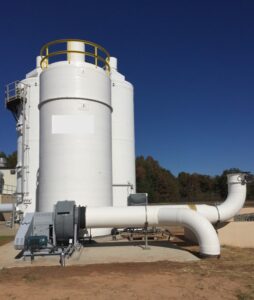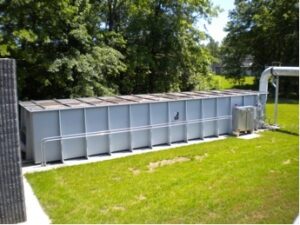Neutralizing Ammonia Odor Without Guesswork: Why Data-Driven Control Matters
 Ammonia odors are a common problem in many industrial and municipal facilities. These odors are strong, easy to detect, and difficult to control without the right tools. Trying to solve the issue with a one-size-fits-all method usually leads to poor results.
Ammonia odors are a common problem in many industrial and municipal facilities. These odors are strong, easy to detect, and difficult to control without the right tools. Trying to solve the issue with a one-size-fits-all method usually leads to poor results.
At Webster Environmental Associates (WEA), we use real data to address these challenges. We don’t guess what might work. Instead, we start by learning exactly where the odor is coming from, how strong it is, and what’s causing it. That way, we can recommend a system that truly works for the facility, not just on paper.
What Makes Ammonia Odor Unique
Ammonia has properties that make it harder to control than many other odors. It is very volatile, which means it spreads through the air quickly. People can smell ammonia at low levels, and even a small leak can cause discomfort or complaints.
Ammonia doesn’t always act alone, either. It often mixes with other odor-causing compounds like hydrogen sulfide. These mixtures can change how the odor smells, how far it travels, and how hard it is to treat. Because of this, facilities can’t rely on just one number or one test to get the full picture.
Health risks are also a concern. At high levels, ammonia can irritate the eyes, nose, and lungs. Even at lower levels, it can affect indoor air quality and lead to complaints from workers or nearby residents. Controlling it is not just about comfort—it’s about safety and compliance.
How WEA Uses Air and Liquid Sampling to Understand the Problem
Before we recommend any type of odor control system, we take time to fully understand the problem. We start with a detailed odor study. This usually involves taking air samples from multiple points around the facility. We also collect liquid samples when ammonia may be forming in process water.
At WEA, we test for both ammonia and hydrogen sulfide. These two compounds often appear together, and they require different treatment methods. Testing them side-by-side helps us decide which system will work best.
We also work with certified odor panels and labs. These panels help us understand how strong the odors are from a human perspective. Labs then test the samples to get accurate readings of the actual chemical levels. This combination of field testing and lab analysis gives us a complete picture of what’s happening on-site.
System Types That Work for Ammonia
 Once we have the test results, we can start thinking about the right system for neutralizing ammonia odor. There are several options, and the best one depends on how much ammonia is present and what other compounds are in the air.
Once we have the test results, we can start thinking about the right system for neutralizing ammonia odor. There are several options, and the best one depends on how much ammonia is present and what other compounds are in the air.
Chemical scrubbers are one of the most effective tools for high-concentration ammonia. These systems use acid-based solutions to react with the ammonia in the air and remove it. They are often the best choice for places like food processing facilities or certain types of manufacturing plants.
For lower ammonia concentrations, biofilters can be a good option. These systems use microorganisms to break down the ammonia and other organic odors. They work best when the odor load is steady and predictable. Biofilters are also a good choice for facilities looking to limit chemical use.
Some sites need a mix of systems to treat different parts of the facility. In those cases, we may recommend a multi-stage approach. For example, we might use a scrubber to remove ammonia, followed by a carbon filter or secondary biofilter to handle any remaining odors. This setup works well at larger treatment plants or facilities with mixed emissions.
Why Customization Is Key
No two facilities are exactly the same. Even if two plants do similar work, their odor control needs can be very different. That’s why we never offer a generic package or off-the-shelf system.
Webster Environmental Associates look at how air moves through the facility, what processes are creating the odors, and what the team’s operational goals are. Some sites want the most cost-effective fix, while others are focused on low maintenance or reducing chemical use. We design each system with those goals in mind.
We also think about future needs. A system that works well today may need to adapt if the facility expands or changes processes. We build flexibility into our designs so clients can make adjustments down the road without starting over.
Work With WEA to Build an Ammonia Control Strategy That Works
Neutralizing ammonia odor takes more than just installing a piece of equipment. It takes the right mix of testing, design, and experience. That’s where WEA comes in. We’ve helped hundreds of clients get control of tough odor problems using smart, data-based strategies.
If you’re dealing with ammonia odors—or want to prevent future issues—now is a good time to act. WEA can help you assess your current situation, recommend the best treatment approach, and support you through the entire process.
Reach out to our team to schedule an odor evaluation or learn more about the services we offer. With the right information and the right partner, controlling ammonia odors doesn’t have to be a guessing game.
